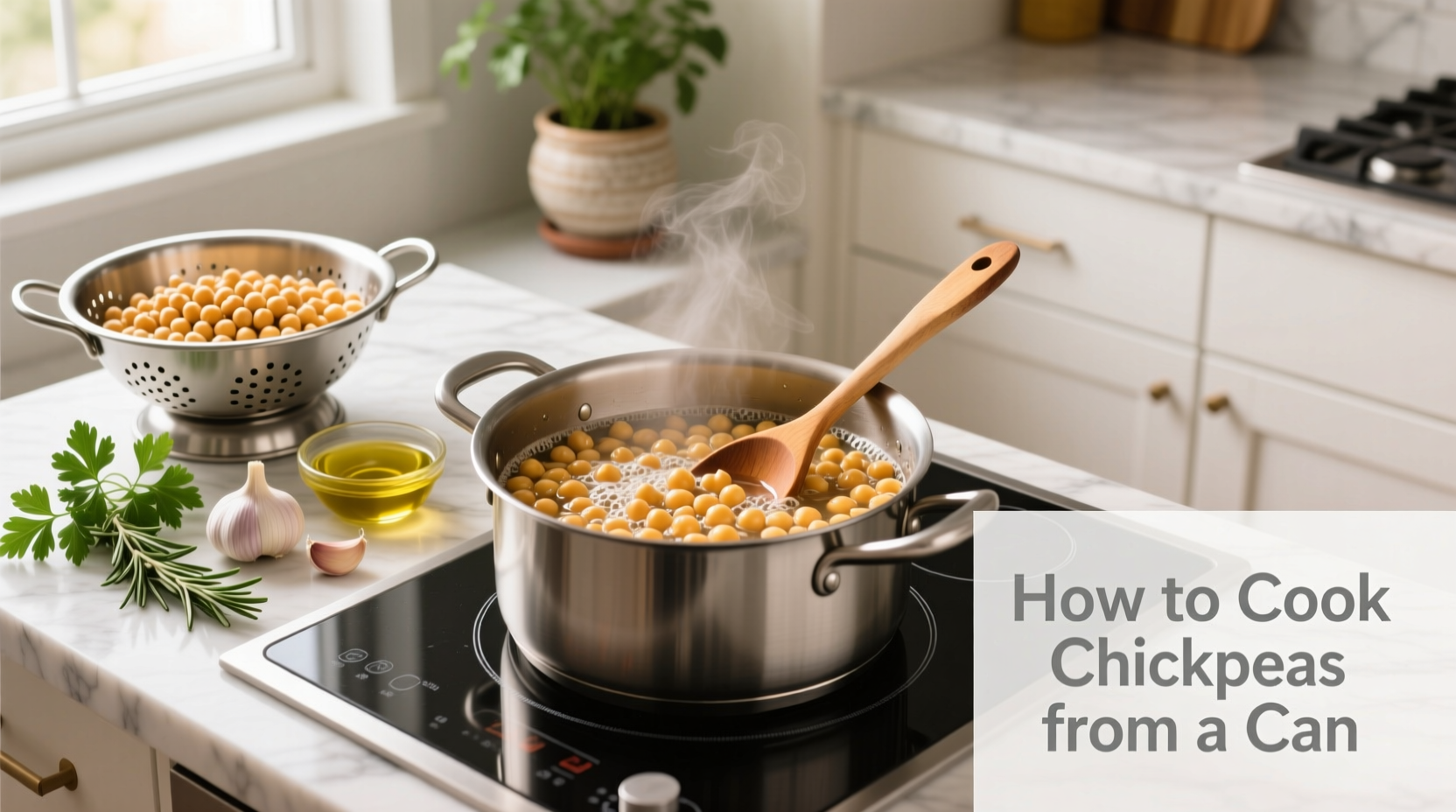Discover how to transform humble canned chickpeas into restaurant-quality dishes with minimal effort. Whether you're meal prepping, making a quick weeknight dinner, or craving crispy snacks, this guide delivers professional techniques you can implement immediately.
Why Canned Chickpeas Deserve a Spot in Your Pantry
Canned chickpeas offer remarkable convenience without sacrificing nutrition. According to USDA FoodData Central, a 1-cup serving provides 14.5g of plant-based protein and 12.5g of dietary fiber while maintaining 90% of the nutritional profile of dried chickpeas cooked from scratch. The time savings are substantial—canned chickpeas require zero soaking and just minutes of active cooking time compared to the 2-3 hours needed for dried varieties.
| Preparation Method | Active Time | Total Time | Sodium Content |
|---|---|---|---|
| Canned chickpeas | 5 minutes | 10-15 minutes | 400-500mg (reduced by rinsing) |
| Dried chickpeas | 15 minutes | 2-3 hours | Naturally low (no added salt) |
Nutritional comparison of chickpea preparation methods (Source: USDA FoodData Central)
Essential Preparation: The Foundation of Great Chickpeas
Proper preparation makes the difference between bland and brilliant chickpeas. Always drain and rinse canned chickpeas thoroughly under cold running water. This simple step reduces sodium content by up to 40% according to research from the USDA Agricultural Research Service. For smoother textures in hummus or purees, take an extra minute to remove loose skins by gently rubbing the chickpeas between your palms under running water.

Three Reliable Cooking Methods for Perfect Results
Stovetop Simmering (Best for Sauces and Salads)
This versatile method works perfectly when incorporating chickpeas into larger dishes:
- Heat 1 tablespoon olive oil in a skillet over medium heat
- Add 1-2 minced garlic cloves and sauté for 30 seconds until fragrant
- Add rinsed chickpeas and ¼ cup liquid (broth, water, or cooking liquid from your recipe)
- Simmer uncovered for 8-10 minutes, stirring occasionally
- Finish with acid (lemon juice or vinegar) and fresh herbs
Oven Roasting (Crispy Chickpea Snack)
For crunchy, snackable chickpeas that satisfy chip cravings:
- Preheat oven to 400°F (200°C) and line a baking sheet with parchment paper
- Thoroughly dry chickpeas with a clean kitchen towel
- Toss with 1 tablespoon oil and seasonings of choice
- Spread in single layer and roast 20-30 minutes, shaking pan halfway
- Cool completely on baking sheet for maximum crispness
The Maillard reaction creates complex flavors during roasting. As explained by the America's Test Kitchen science team, the extended dry heat causes proteins and sugars to interact, developing rich, nutty flavors that can't be achieved through boiling.
Quick Microwave Method (Emergency Meal Solution)
When time is critical:
- Place rinsed chickpeas in microwave-safe bowl with 2 tablespoons liquid
- Cover loosely and microwave on high for 2 minutes
- Stir, then microwave additional 1-2 minutes until heated through
- Add seasonings and let sit 1 minute before serving
Flavor Enhancement Secrets from Professional Kitchens
Seasoning canned chickpeas properly transforms them from bland to brilliant. Professional chefs use these evidence-based techniques:
Layered Seasoning Approach
Add seasonings at different stages for maximum flavor penetration:
- During cooking: Whole spices (cumin seeds, coriander seeds) or aromatics (garlic, onion)
- Midway through: Ground spices (turmeric, paprika) which can become bitter if added too early
- Finishing: Acid (lemon juice, vinegar) and fresh herbs which lose vibrancy with prolonged heat
Perfect Seasoning Combinations
| Cuisine Style | Seasoning Blend | Best Cooking Method |
|---|---|---|
| Mediterranean | Garlic, lemon zest, oregano, olive oil | Stovetop simmer |
| Indian-inspired | Cumin, coriander, turmeric, ginger | Stovetop simmer with tomato |
| Smoky roasted | Smoked paprika, garlic powder, cayenne | Oven roasting |
Safety and Storage Guidelines You Need to Know
Follow these evidence-based food safety practices when cooking with canned chickpeas:
- Always heat chickpeas to at least 165°F (74°C) to ensure food safety, as recommended by the USDA Food Safety and Inspection Service
- Refrigerate cooked chickpeas within 2 hours of cooking
- Store in airtight container for up to 5 days
- Freeze for up to 6 months in portion-sized containers
Discard chickpeas showing signs of spoilage: sour smell, slimy texture, or unusual discoloration. While canned chickpeas have a long shelf life, always check for dented or bulging cans before purchasing, as these can indicate compromised safety.
Creative Applications Beyond Basic Cooking
Once you've mastered basic preparation, explore these professional applications:
Texture Transformation Techniques
Manipulate chickpea texture for different applications:
- Creamy: Simmer with extra liquid and blend while hot for smooth hummus
- Meaty: Roast until deeply browned for vegan "tuna" salad
- Crispy: Roast at high heat with cornstarch for crunchy snacks
Flavor Pairing Science
Understanding flavor chemistry creates better dishes. Chickpeas pair exceptionally well with:
- Acids (lemon, vinegar) which balance earthiness
- Umami boosters (tomatoes, mushrooms, soy sauce)
- Warm spices (cumin, coriander, smoked paprika)
According to sensory research from the Culinary Institute of America, the natural starches in chickpeas create a perfect canvas for flavor absorption, making them exceptionally versatile across global cuisines.
Common Mistakes and How to Avoid Them
Even experienced cooks make these preventable errors:
Skipping the Rinse
The starchy liquid in canned chickpeas contains excess sodium and can create off-flavors. Always rinse thoroughly—this simple step improves texture and reduces sodium by nearly half.
Underseasoning
Canned chickpeas need more seasoning than you might expect. Start with ¼ teaspoon salt per cup of chickpeas, then adjust to taste after cooking. Remember that flavors mellow as they absorb into the chickpeas.
Overcooking for Salads
When using chickpeas in cold salads, undercook slightly as they'll continue to soften as they cool. Perfect salad chickpeas should have a slight bite (al dente) when first removed from heat.











 浙公网安备
33010002000092号
浙公网安备
33010002000092号 浙B2-20120091-4
浙B2-20120091-4